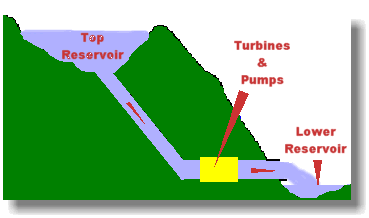 David’s recent post on pumped storage attracted enough angry responses that I guess it is time for a more detailed post on energy storage and renewable sources.
David’s recent post on pumped storage attracted enough angry responses that I guess it is time for a more detailed post on energy storage and renewable sources.
Solar and wind energy are variable sources. If we want them to provide more than 20%-40% of our power, we will need some storage method.
Fortunately, long-distance transmission lines can reduce this need. While the sun and wind have gaps at any one spot, if we use long distance HVDC transmission lines to connect sites thousand of kilometers apart, the sun will be shining or wind blowing somewhere almost all the time. As I pointed out in previous posts, connecting wind farms with such lines could provide a 96% reliable firm commitment with only 12 hours of storage, or a 99%+ reliable firm commitment with 22 hours of storage. With an extensive long-distance grid, most supply gaps shrink to a few hours.
Modular pumped storage (MPS) is not only the lowest cost, but lowest ecological impact electricity storage means available to fill this gap. Separate two artificial reservoirs by a difference in elevation. Pump water uphill when you have extra electricity. Run the water downhill through turbines when you need the power back, recovering from 70-85% of what you put into storage.
Note the word “artificial.” Don’t convert existing rivers, lakes, wetlands, or other water courses for such purposes. Instead, build a closed cycle system with a lined bottom to prevent leakage. Water for this system will essentially be supplied one time, with minor continuing use to replace evaporation and leakage. (If that is still too water intensive, add a cover to minimize evaporation losses.) That way, you don’t end up draining and refilling whole rivers or lakes. You are not trapping organic matter to create methane, or endangering fish and wildlife.
No, not every place in the U.S. has suitable differences in elevation. But somewhere along the greatly extended grid we will need to smooth supply variations from these sources, we can also find elevation differences suitable for modular pumped storage systems.
Nor is the land area particularly extensive. If you look in the second tab of the online spreadsheet I created on this subject you will see that such storage will require less than 2000 (revision) square miles to provide about 12 hours of use, less than 4000 square miles to supply 22 hours worth — assuming at least an average 875 foot elevation. This compares to about 42,000 square miles (compressed DBF database) current hydroelectric dams require. (Note: this download contains no summary information. You have to add up the numbers yourself.) You can also look on it as 56-102 square feet(revised) of pumped storage per U.S. household.
I think you will find similar numbers apply for other nations and other continents. Modular pumped storage could supply the storage for every continent in the world, with around one fiftieth the ecological impact of the dams or coal mines or other dispatchable sources it helped displace.
My next post will go beyond long-distance lines and pumped storage to demand management and thermal storage. But while these can reduce the need for electrical storage, they will not eliminate it. We will have to store some electricity as electricity. Pumped storage is the best way we know how to do this today.
 David's
David's 

